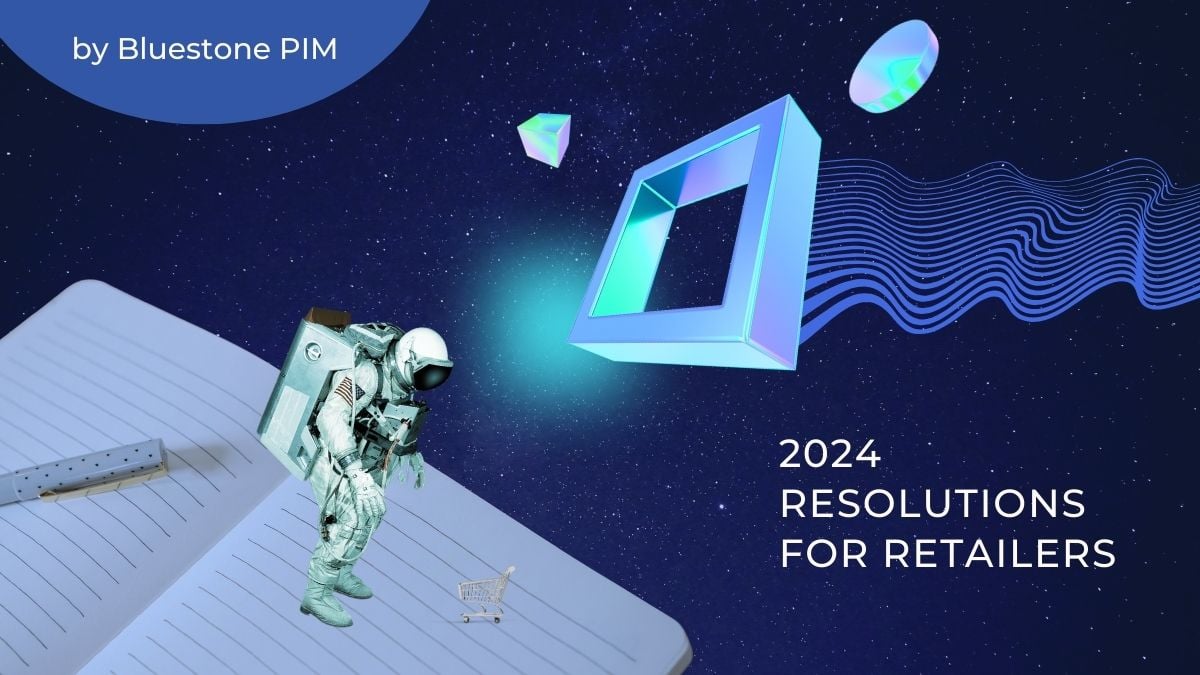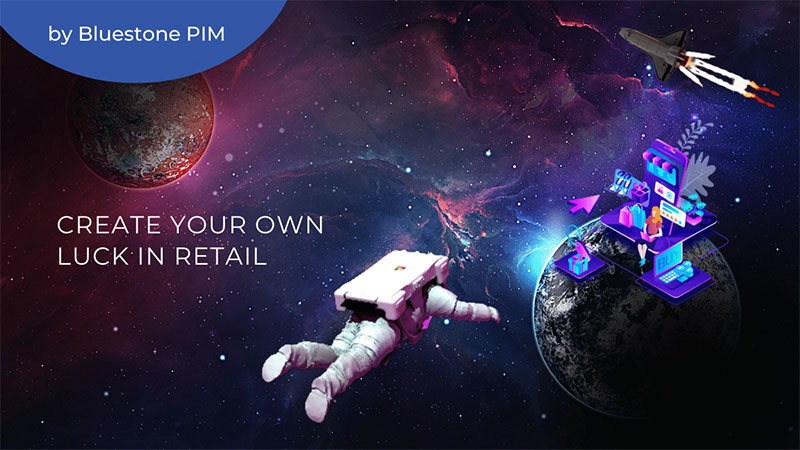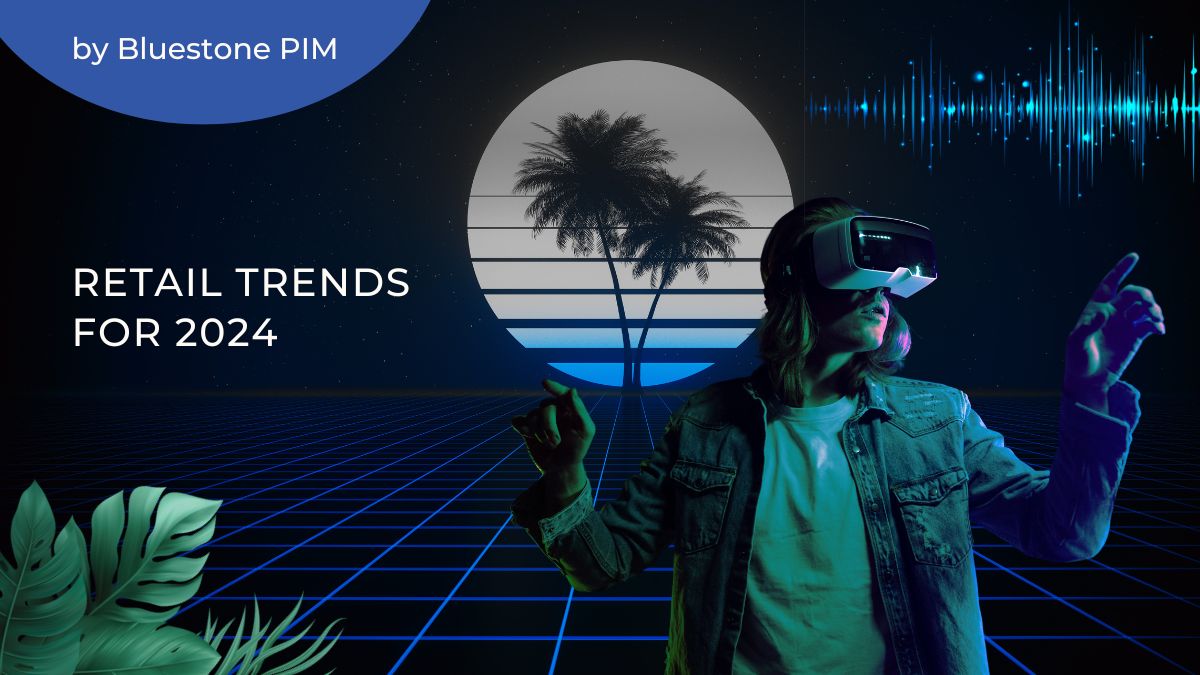Trailblazing the Future of Retail: 6 Resolutions for Success in 2024 and Beyond

Table of Contents
- Resolutions every retailer should make in 2024
- Resolution #1: AI will be my forte
- Resolution #2: May the force of hybrid shopping be with me
- Resolution #3: I will use advanced product information management practices
- Resolution #4: I will advocate for future-proofing the tech stack
- Resolution #5: I will befriend Gen Z shoppers
- Resolution #6: I will go greener
- Conclusion
Do you remember how you shopped in 2013? Maybe you were visiting your favorite grocery store regularly or strolling through a crowded mall with bags in hand. A few taps on your smartphone allow you to compare prices, read reviews, and make informed decisions.
Yet, throughout the last ten years, shoppers have found themselves in a retail space that seamlessly integrates the physical and digital realms. Interactive mirrors suggested accessories that matched our chosen outfit, while smart shelves displayed real-time product information.
Shoppers witnessed a retail revolution, turning stores into experiential hubs where technology enhanced every aspect of the customer journey. The progress of the past decade has not only transformed retail but has also redefined the very essence of how we connect with the products and spaces around us.
So now, let’s delve into the upcoming future of retail.
This article won’t be a crystal ball gazing at futuristic visions or must-haves such as omnichannel, but a list of well-rounded trends worth considering to invest in 2024 and beyond. Moreover, we will explain why you should add these trends as resolutions to your year plan and how to implement them smartly.
Resolutions Every Retailer Should Make in 2024
Retailers can't complain about boredom, for sure. The last years of the pandemic were difficult for the offline sector, followed by inflation. On a regular basis, retail businesses have to keep up with rapidly evolving customer behavior, changes in the technology landscape, and supply chain dynamics.
Although there is no universally applicable solution for safeguarding a retail business's future, you can take steps to anticipate challenges. A forward-thinking approach and agility can keep you unscathed through turmoil in the retail industry.
To help you stay ahead of the years to come, we explored the pivotal trends influencing the landscape and offer practical tips for effectively navigating them. We recommend you add them to your business and marketing strategies.
Resolution #1: AI Will Be My Forte
Artificial intelligence opens up many opportunities for improvement in various retail branches, and companies are eager to use it to create unique shopping experiences or improve inventory management. With the help of AI, you can effectively deliver tailored product recommendations, personalized marketing messages, and even pricing strategies that will encourage your customers to explore your product selections
Retail is one of the ten industries in which the level of AI maturity will be the highest by 2024, according to the Accenture report, when "AI maturity measures the degree to which organizations have mastered AI-related capabilities in the right combination to achieve high performance for customers, shareholders, and employees."
Implementing AI-powered solutions and becoming an AI Achiever requires flexibility, caution, and investment. Generative AI can still be prone to errors, and human supervision is necessary to avoid financial losses and crises.
Furthermore, as Borgar Hestad, EVP of Sales and Marketing at Bluestone PIM, predicts, 2024 might be a litmus test for generative AI models.
Why Is AI Adoption Important?
Artificial intelligence offers unparalleled opportunities to enhance customer experiences and optimize operations by providing personalized recommendations, streamlining inventory management, predicting consumer trends, and automating routine tasks, to name a few benefits. In 2024, retail companies can’t afford to ignore this trend.
Pro Tips and Ideas to Implement This Resolution
-
Try AI-powered tools to analyze customer data, including reactions to visual merchandising, in real time. You can use this information to plan store layouts and product placements for maximum impact.
-
Use AI algorithms to analyze market conditions, competitor pricing, and customer demand. Based on this data, you can dynamically adjust product prices for optimal profitability.
Resolution #2: May the Force of Hybrid Shopping Be with Me
The eCommerce sector has grown significantly during the pandemic, and the online sales sector is still forecasted to constitute 41% of global retail sales by 2027, a significant increase from its share of just 18% in 2017, according to new research released by Boston Consulting Group.
But brick-and-mortar is not dead at all. Forrester predicts that US offline retail sales will reach $4.2 trillion by 2028. Customers gradually began to return to physical stores. Offline retail is gaining an exciting new lease of life to create exceptional shopping experiences synchronized with digital features.
This power duo of offline and online shopping is called hybrid retail, and it aims to provide customers with a remarkable experience in both channels.
The hybrid retail concept involves offering amenities such as Buy Online, Pickup in Store (BOPIS), Browse In-Store, Purchase Online (BIPO), and ship-to-home options. The key is to provide consistent product information and pricing, letting customers switch seamlessly between all channels.

Hybrid retail is often paired with other retail trends, such as retailtainment and experimental retail, that combine shopping with entertainment, education, in-store events, mobile apps, and virtual reality (VR) and augmented reality (AR) games. Their primary purpose is to make shopping an exciting entertainment.
Why Is Hybrid Retail Important?
The concept of hybrid retail brings the best of both commerce worlds together, offering the convenience of online shopping and immersive aspects of physical stores. This approach helps retailers enhance accessibility and cater to diverse consumer expectations to build brand loyalty.
Pro Tips and Ideas to Implement This Resolution
Advanced technologies are your friends. Use them to bridge the gap between online and offline interactions, ensuring a seamless customer journey.
-
Integrate virtual try-on features and augmented reality tools into online platforms, allowing customers to virtually experience products before making a purchase decision. Get inspired by Sephora’s Virtual Artist app.
-
Optimize mobile applications to provide a frictionless transition between mobile shopping and in-store experiences. Features like mobile payments and digital loyalty programs enhance convenience for customers.
Resolution #3: I Will Use Advanced Product Information Management Practices
Customers make online purchases, predominantly relying on product information such as product descriptions, images, and specifications. Specifically, details on a product’s environmental impact and supply chains are crucial for conscious and environmentally aware customers.

Providing product information through various channels and touchpoints is pivotal for hybrid shopping and mastering omnichannel sales. The way you manage product information and create product stories makes a difference and affects your competitive advantages.
Managing product information in different contexts, channels, and languages in a comprehensive product portfolio of over 500 SKUs is almost impossible manually, but technology comes to the rescue.
Modern Product Information Management (PIM) platforms enable retailers to centralize information in one repository, easily enrich the content in teams, cooperate with suppliers, integrate PIM with other applications via API protocols, and many other advanced functionalities.
Why Is Product Information Management Important?
By providing up-to-date and detailed product content, effective product information management streamlines operations, builds customer trust, and makes it easier for customers to shop.
Implementing advanced product information practices helps you ensure the accuracy, consistency, and accessibility of product data across various channels. This data harmony will pay off in the customer's experience, affecting your bottom line.
Pro Tips and Ideas to Implement This Resolution
-
Establish a centralized database for product information to maintain consistency across all channels. In this way, customers get accurate information no matter where they interact.
-
Make your product information more appealing by adding high-quality images, videos, and detailed descriptions. This not only improves the customer experience but also aids in search engine optimization (SEO) for online platforms.
Resolution #4: I Will Advocate for Future-Proofing the Tech Stack
It is hard to imagine the growth of retail businesses without technology. Yet, purchasing and integrating a solution with the company’s infrastructure is not a simple and quick process.
According to Gartner Digital Markets insights, 57% of retailers plan to spend more on software in 2024, and they set marketing and IT investments as a priority. The same survey also shows that nearly half (49%) of retailers who invested in software last year regretted their purchase.
Future-proofing the tech stack has always been a top priority for retailers, and many readers will recognize this as a New Year’s resolution from the past. But with technology development and innovations happening at an unprecedented pace, it’s hard to establish solutions that will stay relevant long-term. That’s where a composable commerce approach comes in. This architecture allows you to build your tech stack using a set of components that can be integrated, decoupled, and replaced as your needs change. As such, a composable commerce solution is not static and allows you to continuously re-design your tech stack.
With a composable commerce platform, you’ve got a solution that is flexible and scalable to support your business forever. No more costly upgrades, end-of-life situations, or technical debt. The development of your platform is no longer in the hands of a solution provider. Instead, you are in charge of your platform to ensure it adapts to fit your evolving business needs.
— Christian Evensen, Senior Commerce Advisor, Avensia
By breaking down monolithic legacy commerce systems into modular components, retailers can easily integrate new technologies, scale their operations efficiently, and deliver a more personalized and seamless shopping experience.
Composable commerce approach is a good direction for enterprises that want to be flexible and gain full control over their tech stack.

An example of a composable tech stack
Why Is Investing in Future-Proof Technology Important?
By investing in scalable, adaptable, and cutting-edge technologies, retailers can ensure their systems remain relevant, resilient, and capable of integrating emerging innovations. Future-proofing safeguards against obsolescence and positions retailers to capitalize on new opportunities as they arise.
Pro Tips and Ideas to Implement This Resolution
-
Invest in technologies that boost the customer experience, such as personalized marketing tools, chatbots, and virtual assistance. Long-term relevance comes from aligning tech investments with customer needs.
-
Prioritize systems that support open APIs (Application Programming Interfaces) for seamless integration with third-party applications and future technologies. This enhances interoperability and flexibility.
Resolution #5: I Will Befriend Gen Z Shoppers
Generation X and Millennials still hold the most spending power. Yet, the percentage of Zoomers born between the mid-1990s and early 2010s is growing significantly. As its first representatives enter the labor market, their purchasing power will increase. Bank of America estimated that Gen Z's spending power would surpass Millennial's in 2031 and increase by 400% over the next decade to $33 trillion.
Generation Z has unique shopping habits, and they not only buy but also influence other age groups and push companies to be more innovative, transparent, and sustainable.
Why Should You Address More Activities to Generation Z in 2024?
As you already know, Gen Z represents a significant consumer base with unique preferences and purchasing power. Crafting campaigns tailored to their values, digital savviness, and desire for authentic experiences is crucial for capturing their attention and loyalty.
Pro Tips and Ideas to Implement This Resolution
-
Generation Z values authenticity. Craft genuine and transparent marketing messages that align with their beliefs and showcase the real values of your brand.
-
Optimize online experiences for mobile devices. Zommers are mobile-centric, and campaigns should be easily accessible and navigable on smartphones.
-
Highlight diversity and inclusivity in your marketing campaigns. Generation Z appreciates brands that celebrate different cultures, backgrounds, and perspectives.
Resolution #6: I Will Go Greener
As the sustainability trend in retail and digital product passports gains momentum, businesses are increasingly prioritizing efforts to minimize their environmental footprint. Simultaneously, transparency is gaining significance, driven by consumer demands for greater insights into the origins and production processes of the products they purchase.
73% of Consumer Industry CXOs have increased investments in sustainability over the last year, according to Deloitte’s 2023 CxO Sustainability Report. Among the top actions taken were using more sustainable materials (65%), increasing the efficiency of energy use (62%), using energy-efficient or climate-friendly machinery, technology, or equipment (53%), and developing a new climate-friendly product or service (50%).
Consumers increasingly prioritize eco-friendly and socially responsible practices. European Commission is working on a Digital Product Passport (DPP). To stay competitive, retailers must — firstly — adopt sustainable technologies to reduce carbon footprints. Secondly, they should address the transparency and traceability of their product information throughout the supply chain.
— Borgar Hestad, EVP Sales and Marketing at Bluestone PIM
Why Should You Add More Sustainable Practices to Their Actions in 2024?
Do you want to meet growing consumer demand for environmentally responsible choices, enhance your brand reputation, and contribute to global sustainability goals? If yes, then there is no other way than to embrace sustainability and make your retail store greener.
Pro Tips and Ideas to Implement This Resolution
-
Use recyclable and biodegradable packaging materials to minimize environmental impact. Consider reducing excess packaging to further cut down on waste.
-
Set up recycling programs within your stores and encourage customers to participate. Minimize single-use items and explore ways to repurpose or recycle unsold goods.
Conclusion
As we step into the future of retail, we wanted to support you with these six resolutions you can add to your marketing strategy for success in 2024 and beyond. Nothing is certain, but industry leaders' strategies and solid data from research firms show that AI, sustainability, and all the trends presented in this article are here to stay and rise, affecting retail stores of all sizes.
Above all, we encourage you to stay flexible and forward-thinking and invest in future-proof technology because it will have your back in the ever-evolving retail landscape. The future is bright! Good luck with your plans.




